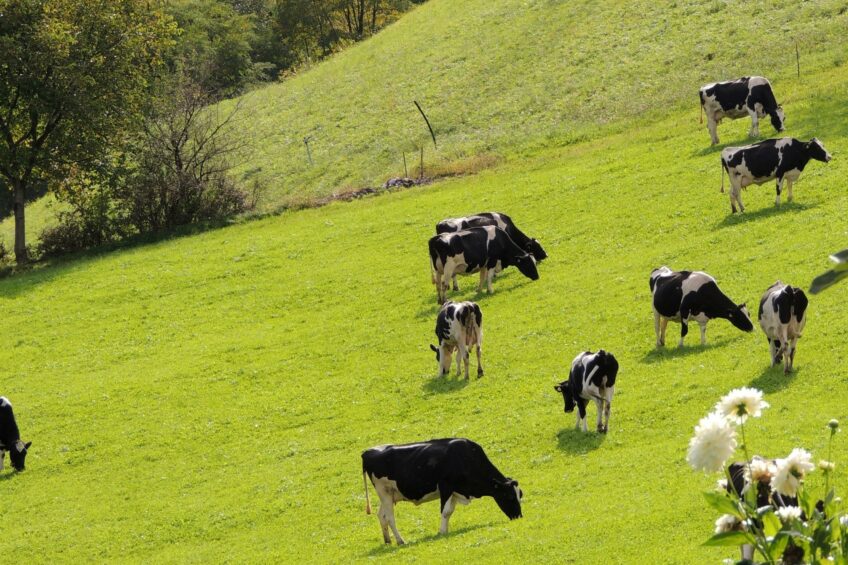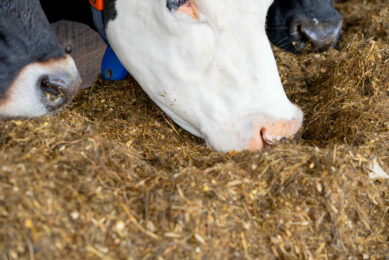Mitigating methane production in the dairy cow’s rumen

Methane production in the rumen often inhibits normal rumen fermentation and results in loss of dietary energy that could otherwise be used for productive purposes. In lactating cows, a 20% reduction in methane emissions represents the same amount of energy needed to synthesise 0.6 kg/d of milk. In terms of animal health, the accumulation of methane with other gases in the rumen results in cows being ill with bloat, leading to respiratory distress. This article considers feeding strategies that can reduce methane problems and improve health and performance.
Methane emissions are commonly lower with higher proportions of forage legumes in the diet due to lower fibre content, faster rate of passage, and, in some cases, the presence of condensed tannins. In one study, replacing timothy grass hay with alfalfa hay substantially decreased (-21%) methane production.
Within the same forage legume species, methane production may further be influenced by the conservation method. It was found that methane production was decreased (-33%) by using alfalfa silage instead of alfalfa hay diets and that the energy lost as methane was also lower (-4%) with alfalfa silage. This result has been attributed to the enhanced rumen microbial efficiency (+9%) with alfalfa silage and the decreased volatile fatty acids production, which is stoichiometrically related to methane emission.
Forage-to-concentrate ratio
A linear decrease in methane yield was found with high-concentrate diets due to the diversion of hydrogen into propionate fermentation resulting in less hydrogen being available for methanogenesis. By contrast, high forage stimulates acetate fermentation, which results in a net increase in hydrogen production and methane emissions.
The response to high-concentrate diets may, however, vary depending on the breed of cows. Holstein cows seem to benefit most from a high-concentrate diet due to the larger reduction in methane yield (27.2%) compared with Jersey cows (13.8%). This is probably caused by the higher acetate molar proportion, lower propionate proportion, and smaller reduction in acetate-to-propionate ratio in response to the high-concentrate diet for Jersey cows compared with Holstein cows.
Protein nutrition
The supply of highly digestible protein reduces the amount of structural carbohydrates and contributes toward increasing the dry matter intake and reducing the intensity of methane emissions per unit of dry matter intake. However, in some cases, such as dry cows and goats, methane production per unit of dry matter intake and the ratio of methane energy loss to metabolisable energy intake increased from 29 to 34 litres per kg dry matter with the rise in crude protein content of diets from 4% to 9%. It is unwise, though, to reduce methane production by reducing the supply of protein, as there will be negative effects on animal productivity and health.
Fat supplement
Incorporating fat in the diet as an energy source lowers the carbohydrate content, which is the substrate for methane formation. It also inhibits methanogenesis due to the toxicity of long-chain fatty acids to methanogenic bacteria. However, the effect of fats on methane production may vary depending on the fat source (Table 1). This may be attributed to the bio-hydrogenation of unsaturated fatty acids in the rumen, promotion of propionic acid production, and prevention of protozoa activity.
Use of additives
Essential oils are volatile and aromatic oily liquids extracted from plant materials such as flowers, seeds, buds, leaves, herbs, wood, fruits, and roots. They can inhibit methane production by limiting the hydrogen availability for methanogens and indirectly inhibit the growth of protozoa.
Ionophores such as monensin and lasalocid are generally used as feed additives to improve the efficiency of digestion in ruminants. Lasalocid is specifically active against hydrogen-producing bacteria and results in higher propionate production, which is related to low methane production.
Enzymes, such as cellulase and hemicellulose, are also used for mitigating methane production in the rumen. They improve fibre digestibility and typically lower the acetate-to-propionate ratio in the rumen, ultimately reducing methane production.
Bee glue extract also reduces methane production in the rumen by stimulating the rumen microorganisms for the consumption of hydrogen by changing total volatile fatty acids. However, further work is needed to study the effect of bee glue on the mitigation of methane emissions under different botanical origins, climatic conditions, and collection methods for more effective applications.
Defaunation
Rumen protozoa play an important role in methane production, particularly when cattle are fed high-concentrate diets. Rumen methanogens have been observed attached to protozoal species suggesting possible interspecies hydrogen transfer. These protozoa-associated methanogens have been variously reported as contributing up to 37% of total rumen methane emissions. Therefore, the removal of protozoa from the rumen (defaunation) is associated with a decrease in methane production. In this case, cattle may be fed coconut oil distillate rich in lauric acid to suppress rumen protozoa for at least 7 days before 3 days of oral dosing with sodium 1-(2-sulfonate-oxy-ethoxy) dodecane.
Feeding frequency
Low feeding frequencies tend to increase the propionate-to-acetate ratio and lower methane production in the rumen of dairy cows. This effect is associated with lowering methanogens as a result of high fluctuations in rumen pH since low feeding frequencies increase diurnal fluctuations in rumen pH that can be inhibitory to methanogens.
On the other hand, the higher feeding frequency (e.g., 5 versus 2 times daily) tended to elevate rumen pH and increase acetate-to-propionate ratio and milk fat percentages. Producers are, therefore, encouraged to increase their feeding frequency to reduce daily fluctuations in rumen pH and to ensure efficient digestion and milk production. Thus, low-frequency feeding as a strategy to reduce methane production would not be practical for producers.
Grazing
Grazing management strategies have the potential to decrease methane production. In a study comparing continuous versus rotational stocking systems, continuous stocking resulted in lower emission intensity compared with a rotational system. In this study, however, it was found that rotating cattle among paddocks at a target residual forage height of 11 cm resulted in decreased methane production compared with that of a traditional rotational system, which had a target residual forage height of 5 cm.
It was also shown that methane emissions can be reduced by up to 25% when feeding cattle on fast-growing grass. Further, the use of multispecies grasses allows complementary actions of their chemical compounds which alter carbohydrate metabolism in the rumen towards a high propionate-to-acetate ratio and also divert surplus hydrogen away from methane production and into microbial cells.
Including legumes in the grasses grazed also decrease methane production due to the lower fibre content and the higher passage rate through the rumen, as indicated earlier. In addition, legume plants have a higher tannin content which can promote greater efficiency and synthesis of microbial biomass and decrease the output of enteric methane by 12-23%. The concentration of tannins in legume plants and their effect on methane production in the rumen is, however, affected by various management and environmental factors such as nutrient soil composition, light intensity, and air temperature.
Join 13,000+ subscribers
Subscribe to our newsletter to stay updated about all the need-to-know content in the dairy sector, two times a week.










